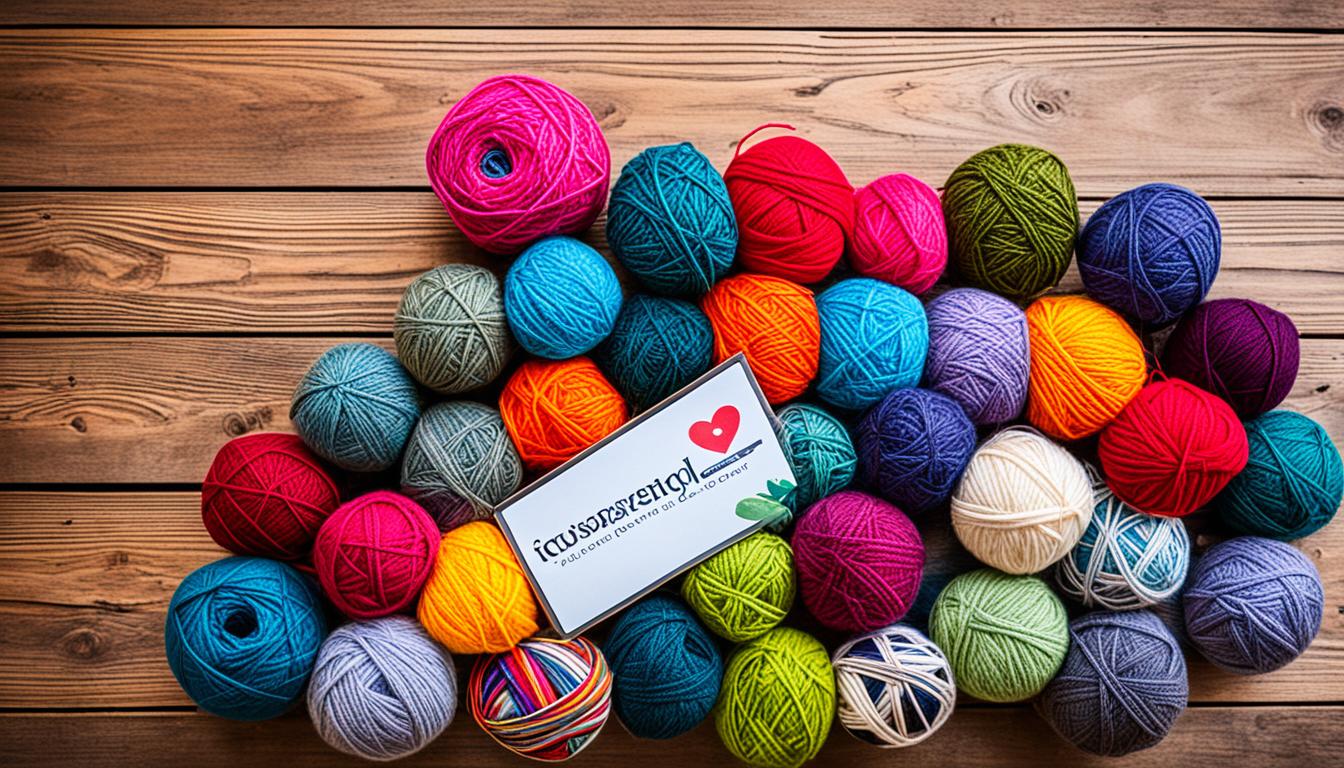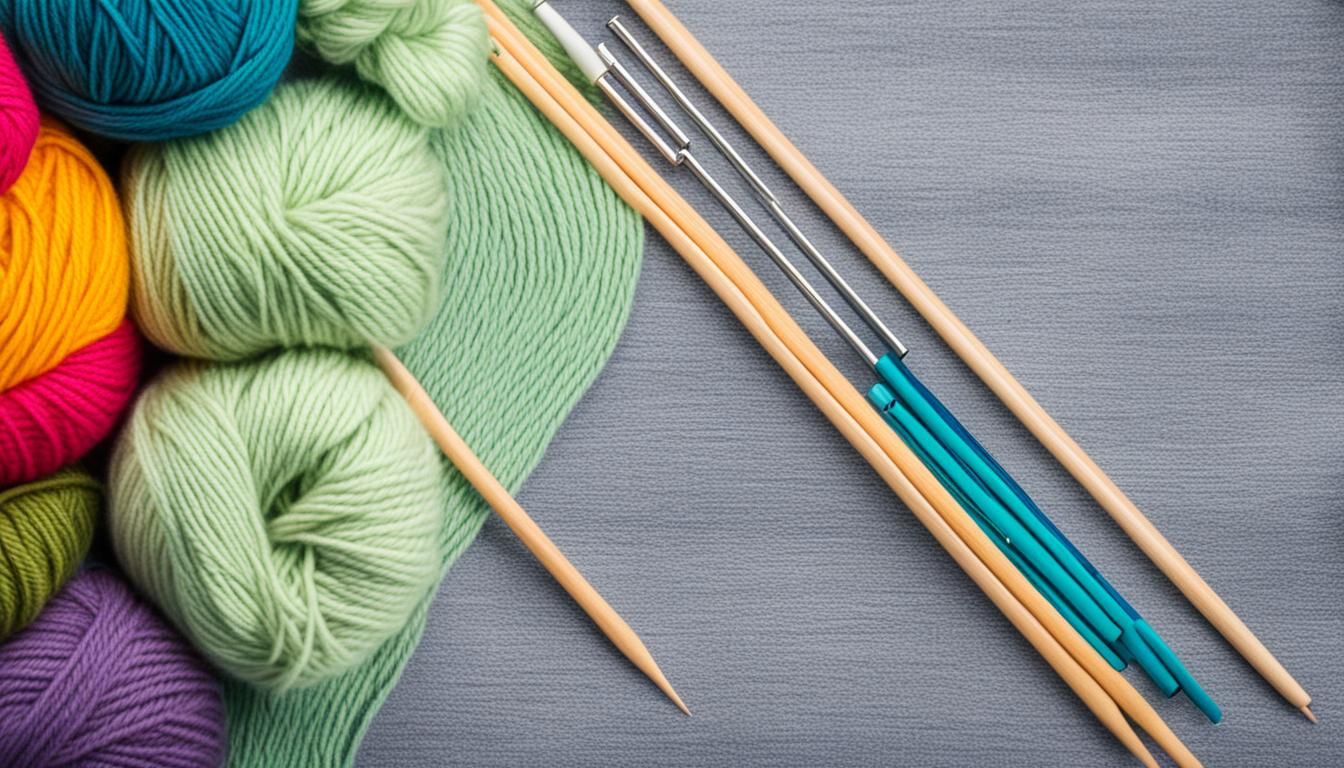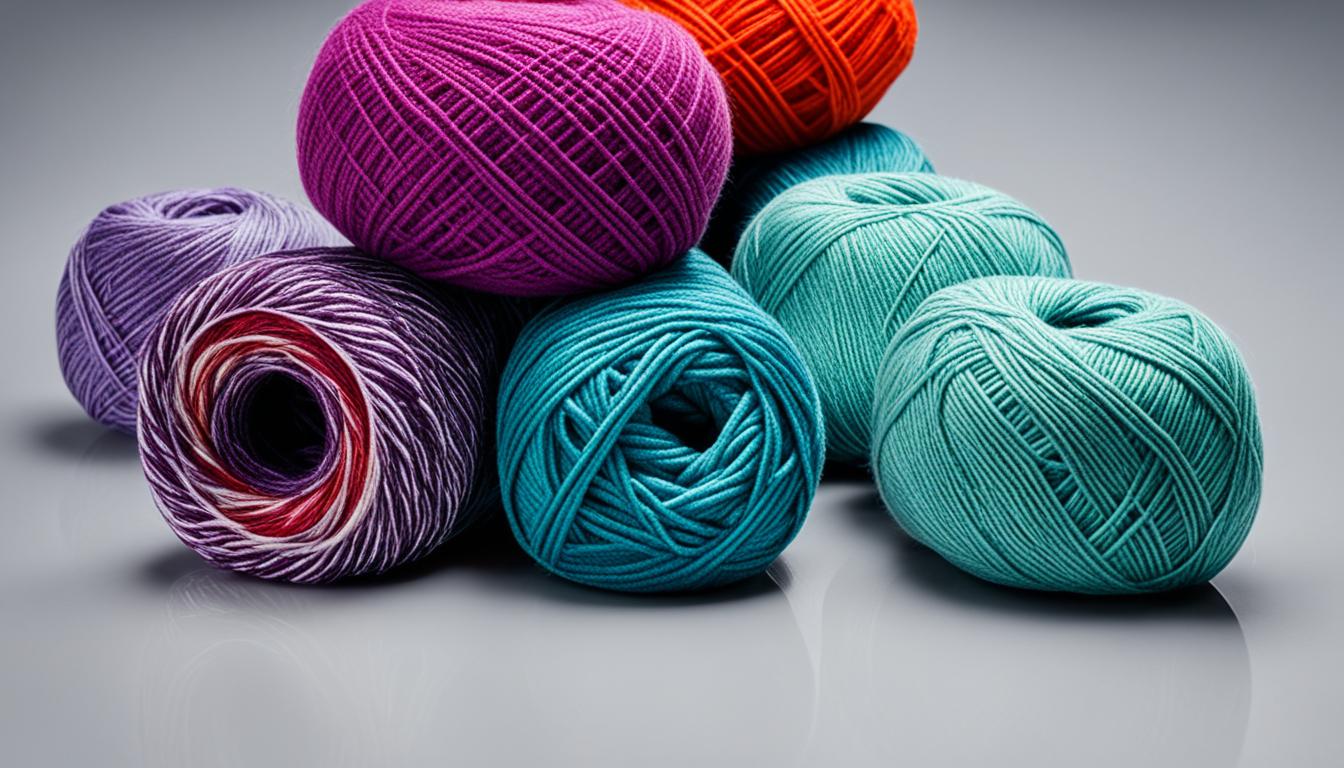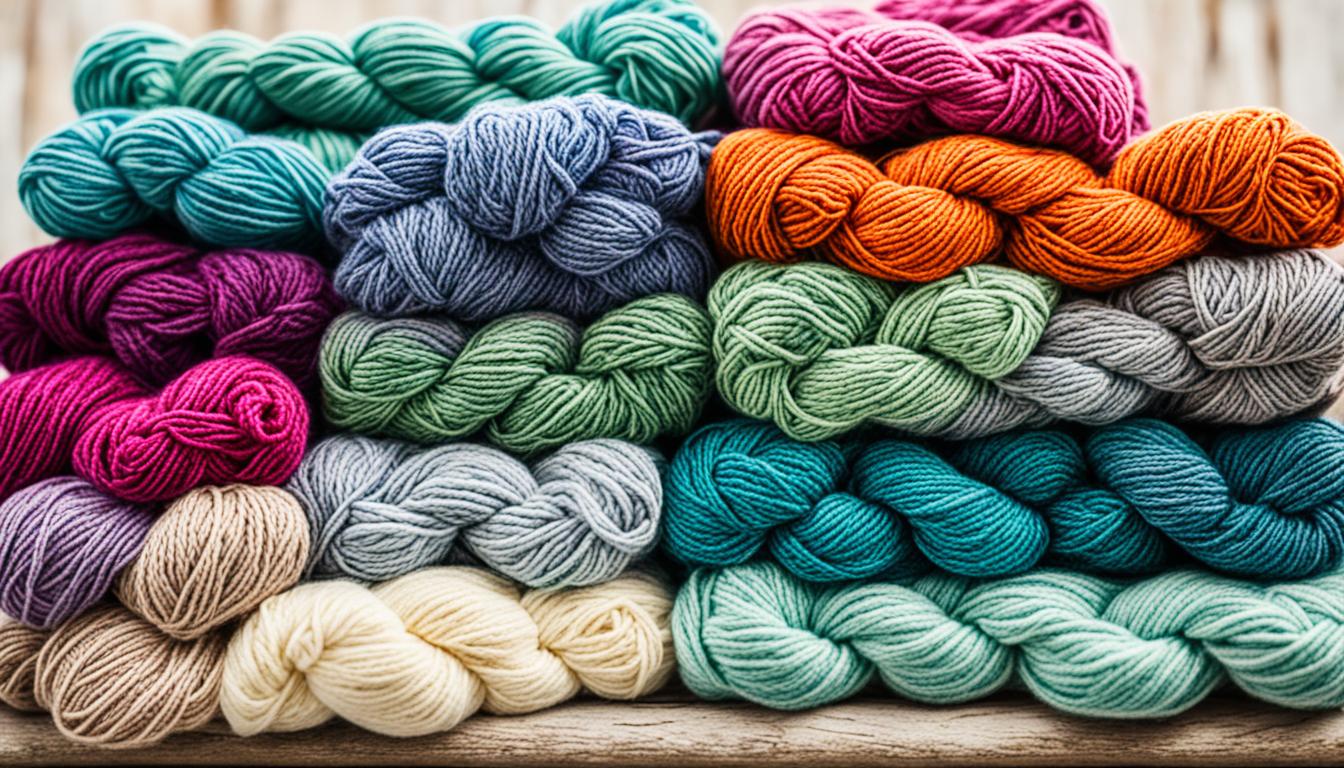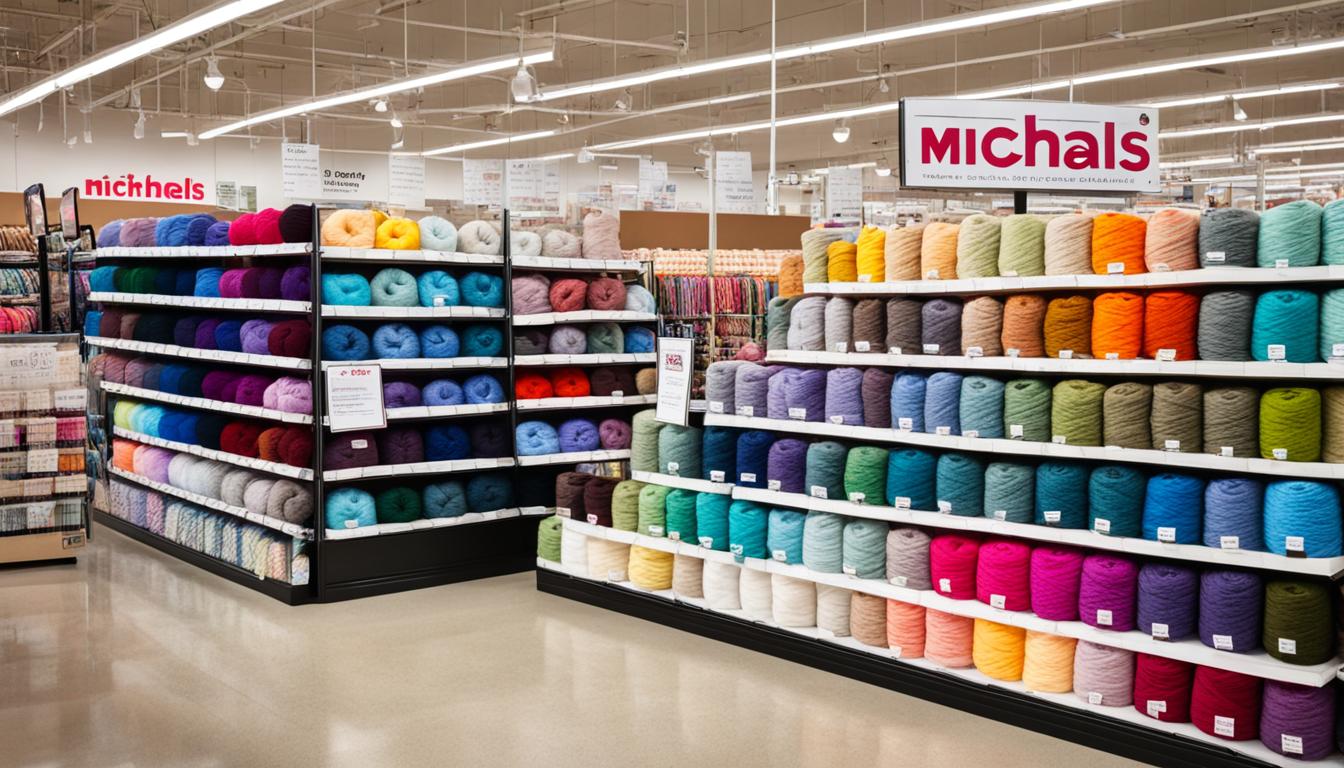Hamsters are known for their chewing behavior, but when it comes to yarn, there are important considerations. While yarn may seem like a tempting chew toy for your furry friend, it is crucial to understand if it is safe for them to chew on. Let’s explore the safety of yarn for hamsters and whether it can have harmful effects on their health.
Key Takeaways:
- Yarn poses risks for hamsters, including the potential for injuries and digestive issues.
- Certain types of yarn may be toxic to hamsters if dyed or treated with chemicals.
- Safe alternatives to yarn include natural chew toys made from wood or other pet-safe materials.
- Creating a hamster-safe environment and supervising their chewing behavior are crucial.
- If you have concerns, consult with a veterinarian for expert advice.
The Potential Risks of Yarn for Hamsters
Hamsters are curious creatures with a natural inclination to explore and chew on various objects they encounter. While yarn may seem like an innocent and enticing toy for your hamster, it can actually pose several dangers to their health and safety.
One of the primary risks of yarn for hamsters is the potential for limb or teeth injuries. The fibers of yarn can easily wrap around their delicate limbs or get tangled in their teeth, causing painful entanglements and even serious injuries. This can significantly impact their overall well-being and quality of life.
Additionally, yarn ingestion can lead to detrimental consequences for hamsters. If a hamster swallows yarn, it can create blockages in their digestive system, posing a severe threat to their health. Digestive issues and intestinal blockages can result in discomfort, pain, and potential complications that may require veterinary intervention.
Moreover, certain types of yarn, particularly those that are dyed or treated with chemicals, can be toxic to hamsters. These toxic substances can have harmful effects on their delicate systems and may lead to serious health issues if ingested.
“Hamsters may find yarn appealing to chew on, but it’s essential for owners to be aware of the potential risks associated with this activity.”
To prevent yarn ingestion and safeguard your hamster’s well-being, it’s crucial to take proactive measures. Implementing a few simple strategies can help mitigate the risks and ensure your furry friend lives a healthy and safe life.
Preventing Yarn Ingestion in Hamsters
1. Keep yarn and other thread-like materials securely stored away from your hamster’s reach.
2. Regularly check your hamster’s environment for any loose threads or yarn remnants that may have dropped or become accessible.
3. Provide safe and suitable alternative chew toys made from pet-friendly materials, such as wooden blocks or chew sticks.
4. Engage in interactive playtime with your hamster using toys specifically designed for their chewing instincts.
By remaining mindful of the harmful effects of yarn on hamsters and taking the necessary precautions, you can create a safe and enriching environment for your pet. Remember, their health and well-being should always be a top priority.
Safe Alternatives to Yarn for Hamsters
When it comes to satisfying your hamster’s natural chewing instincts, there are several safe alternatives to yarn that you can provide. These alternatives not only offer your furry friend a safe chewing experience, but they also stimulate their natural behaviors.
Natural Chew Toys
One great alternative to yarn is natural chew toys made from wood or other pet-safe materials. These toys are designed specifically for hamsters and provide a safe and durable option for them to chew on. You can find a variety of chew toys in pet stores or online retailers.
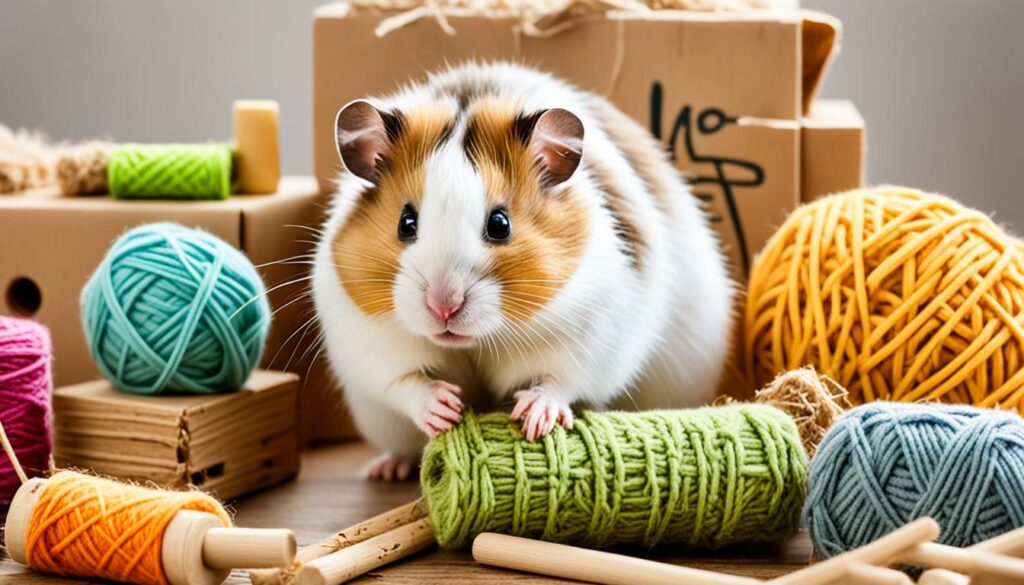
Hay and Straw
Another safe option to consider is offering hay or straw for your hamster to nibble on. Hay and straw not only provide a different texture for your hamster to chew on, but they also offer additional nutritional benefits. Make sure to provide fresh and clean hay or straw for your hamster to enjoy.
Nutritious Treats
Additionally, you can provide your hamster with nutritious treats that are specifically made for small animals. These treats often come in the form of small bites or sticks that are safe for your hamster to chew on. Just make sure to check the ingredients of the treats and choose ones that are free from any harmful substances.
Creating Variety
It’s important to provide a variety of safe alternatives to keep your hamster engaged and prevent boredom. By offering different textures and flavors, you can stimulate their curiosity and natural chewing behaviors.
| Yarn Alternatives | Pet-Safe Materials |
|---|---|
| Wooden chew toys | Safe and durable natural materials |
| Hay and straw | Nutritious and safe for chewing |
| Small animal treats | Specifically made for hamsters |
By offering these safe alternatives, you can ensure that your hamster’s chewing needs are met while keeping them away from potentially harmful materials like yarn. Remember to always supervise your hamster during playtime and regularly inspect their chew toys for any signs of damage. Your hamster’s health and safety should always be a top priority.
Creating a Hamster-Safe Environment
When it comes to keeping your hamster safe, proactive measures are key. By creating a hamster-safe environment, you can prevent accidents and reduce the chances of yarn ingestion, safeguarding your furry friend’s well-being.
One of the first steps is to ensure that your hamster’s cage is free from any yarn or loose threads that they could potentially chew on. These seemingly innocent items can pose a risk if ingested, potentially leading to health complications. Regularly inspect the cage and remove any potential hazards.
To redirect your hamster’s natural chewing behavior, it is vital to provide appropriate chew toys. These toys serve as a safe alternative to yarn and help satisfy their chewing instincts. Choose chew toys made from pet-safe materials, such as wood or specially designed hamster chew toys, to ensure their safety.
Additionally, enriching your hamster’s environment with stimulating activities can help divert their attention away from potential hazards like yarn. Consider providing interactive toys, tunnels, and hiding spots to keep them engaged and entertained.
Remember, prevention is key when it comes to maintaining a hamster-safe environment. By taking these steps, you can ensure that your hamster remains happy and healthy, free from the risks associated with yarn ingestion.

Recognizing Signs of Yarn Ingestion in Hamsters
As a responsible hamster owner, it is crucial to be vigilant and aware of the signs that your furry friend may have ingested yarn. Hamster chewing behavior is a natural instinct, but consuming yarn can have harmful effects on hamsters if left untreated. By recognizing the symptoms early on, you can take prompt action to protect your pet’s health.
1. Decreased appetite: If you notice that your hamster is not eating as usual, it could be a sign of yarn ingestion. The presence of foreign material in their digestive system can cause discomfort and loss of appetite.
2. Lethargy: A hamster who has ingested yarn may appear lethargic or less active than usual. This could be a result of digestive distress or discomfort caused by the foreign object.
3. Bloating: Yarn can create blockages or obstructions in a hamster’s digestive tract. As a result, you may notice your hamster’s abdomen becoming distended or bloated.
4. Changes in bathroom habits: Yarn ingestion can interfere with a hamster’s ability to pass stool normally. You may observe changes in their bathroom habits such as constipation or diarrhea.
If you suspect that your hamster has ingested yarn or is displaying any of these symptoms, it is crucial to seek veterinary care immediately. A veterinarian trained in small animal care will be able to diagnose any potential issues and recommend appropriate treatment.
| Signs of Yarn Ingestion | Action |
|---|---|
| Decreased appetite | Seek veterinary care |
| Lethargy | Seek veterinary care |
| Bloating | Seek veterinary care |
| Changes in bathroom habits | Seek veterinary care |
Remember, early detection and prompt action are key to ensuring the well-being of your hamster. Regularly inspect their habitat for any stray yarn and provide safe alternatives for their chewing behavior. By prioritizing your pet’s health, you can create a safe and loving environment for them to thrive in.
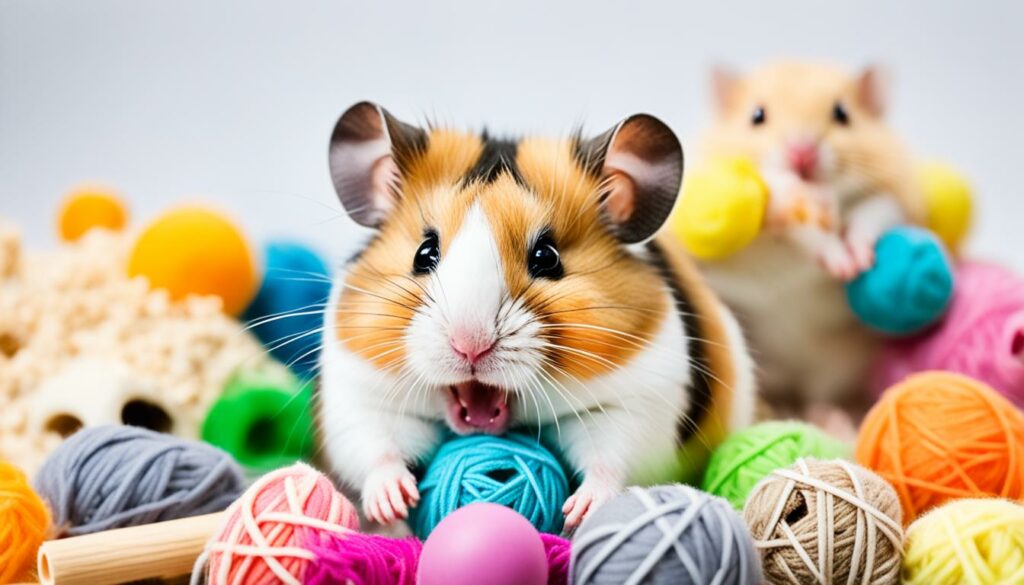
Hamster-Safe Toys and Cage Accessories
When it comes to choosing toys and accessories for your hamster, it is crucial to prioritize their safety. Opt for items specifically designed for hamsters and made from pet-safe materials. By doing so, you can provide your furry friend with a stimulating and secure environment. Avoid using fabric toys or items with loose threads or fibers that could pose a choking or entanglement hazard.
Exploring Toy Options
To ensure the safety of your hamster, consider the following toy alternatives:
- Wooden chew toys: Hamsters have a natural instinct to chew, making wooden chew toys an excellent choice. These toys not only provide mental stimulation but also help keep their teeth healthy. Look for toys made from untreated, pet-safe wood.
- Mineral chews: Mineral chews are a great addition to your hamster’s cage. They are designed to provide essential minerals while satisfying their chewing needs. Opt for mineral chews made with natural, pet-safe ingredients.
- Exercise wheels: Exercise wheels are an essential accessory for keeping your hamster active. Choose a solid-surface wheel without any gaps that could trap their tiny paws.
- Tunnels and hideouts: Hamsters enjoy having cozy hideouts and tunnels to explore. Look for options made from hamster-safe materials, such as plastic or ceramic, and avoid those with small parts that can be chewed off.
Creating a Safe Play Space
In addition to choosing appropriate toys, it is essential to create a safe play space for your hamster. Remove any potentially hazardous items and ensure there are no loose threads or fibers in their cage. Regularly inspect their toys and accessories for signs of wear and replace them if necessary. This will help prevent any accidents or injuries.
| Common Hamster-Safe Materials | Avoid |
|---|---|
| Natural wood | Fabric toys with loose threads |
| Mineral chews | Plastic toys with small parts |
| Ceramic hideouts | Items treated with chemicals |
By providing hamster-safe toys and cage accessories, you can ensure your furry companion stays entertained, mentally stimulated, and safe from potential hazards. Remember, their well-being is in your hands!
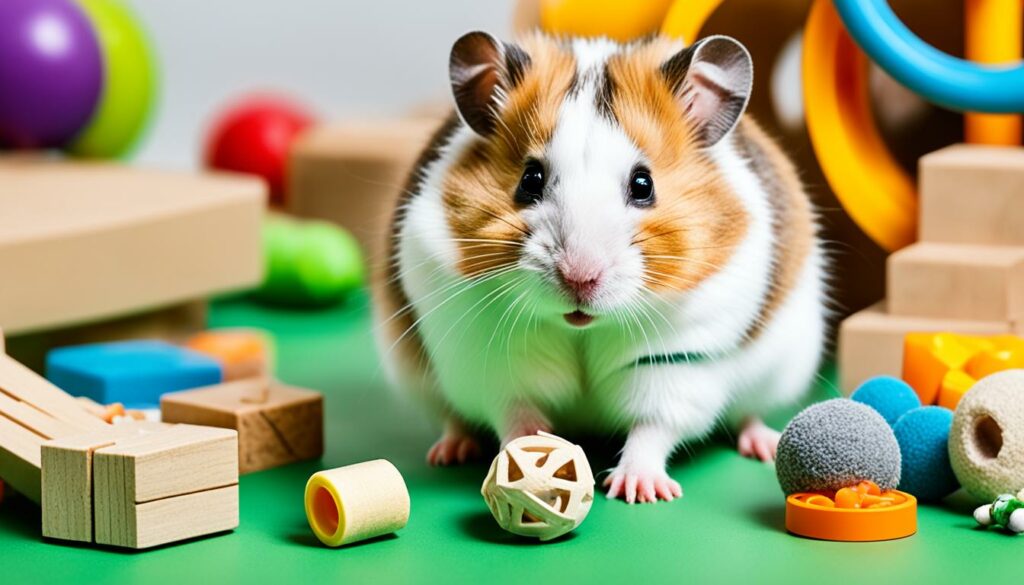
Educating Yourself on Hamster-Safe Products
When it comes to ensuring the safety of your beloved hamster, it is crucial to stay informed about hamster-safe products. By educating yourself on the materials and brands that are safe for your furry friend, you can make well-informed choices that prioritize their well-being. Here are some key steps to help you in your research:
- Research different brands: Take the time to explore reputable brands that specialize in pet products. Look for those that have a track record of providing safe and reliable items for small animals.
- Read reviews: Customer reviews can offer valuable insights into the quality and safety of specific products. Pay attention to any feedback related to the safety and durability of hamster chew toys and accessories.
- Look for specific labels: When selecting products for your hamster, keep an eye out for labels that explicitly mention their safety for hamsters. This ensures that the materials used have been tested and approved for use with small animals.
Yarn Alternatives for Hamsters
While yarn may not be the safest option for your hamster to chew on, there are plenty of alternatives that can provide them with a satisfying chewing experience. Consider the following yarn alternatives:
- Wooden chew toys: Natural wood chew toys are a popular choice for hamsters. They are safe, durable, and can help keep their teeth in good condition.
- Twig balls or sticks: Hamsters enjoy nibbling on small twigs or twig balls, which not only satisfies their chewing instincts but also provides mental stimulation.
- Woven grass toys: Woven grass toys are another great option for hamsters. They are safe for chewing and provide a bit of texture for added interest.
Remember, it’s important to provide a variety of chew toys and rotate them regularly to keep your hamster engaged and entertained.
“Researching and selecting hamster-safe products is a crucial part of being a responsible pet owner. By taking the time to educate yourself, you can ensure the well-being and safety of your furry friend.” – Dr. Emily Richardson, DVM

| Product | Material | Safety Rating |
|---|---|---|
| Wooden Chew Toy | Natural Wood | Safe for Hamsters |
| Twig Balls | Small Twigs | Safe for Hamsters |
| Woven Grass Toy | Grass | Safe for Hamsters |
Table: Examples of Hamster-Safe Chew Toys and Their Materials
Consulting with a Veterinarian
If you have any concerns about the safety of yarn or other materials for your hamster, it is always best to consult with a veterinarian. They can provide you with expert advice tailored to your hamster’s specific needs and help you ensure their overall well-being.
When it comes to yarn toxicity in hamsters or preventing yarn ingestion in hamsters, a veterinarian is your best source of information. They have the knowledge and experience to guide you in making the right choices for your furry friend’s health and safety.
Whether you’re unsure about the types of yarn your hamster can safely interact with or need guidance on preventing yarn-related accidents, a veterinarian can provide the guidance you need. They can also offer recommendations on alternative materials and chew toys that are suitable for your hamster.
By consulting with a veterinarian, you can address any concerns you may have and ensure that you’re taking the necessary precautions to protect your hamster from potential harm. Your veterinarian is there to support you in providing the best care for your hamster.
Expert Insight
“When it comes to your hamster’s health, it’s always a good idea to consult with a veterinarian. They can evaluate your hamster’s unique needs and provide you with advice specific to your pet. Don’t hesitate to reach out to them if you have any questions or concerns about yarn toxicity or preventing yarn ingestion in hamsters.”
Remember, your hamster’s well-being is a top priority, and seeking professional advice from a veterinarian is the best way to ensure their safety. Don’t hesitate to reach out to a trusted veterinarian for guidance and support.

| Veterinarian Consultation Benefits | Explanation |
|---|---|
| Expert advice tailored to your hamster’s specific needs | Veterinarians have extensive knowledge and experience with hamster health and can provide personalized guidance. |
| Prevention of potential harm to your hamster | A veterinarian can help you identify potential risks and provide recommendations to keep your hamster safe. |
| Understanding alternative materials and chew toys | Your veterinarian can suggest safe alternatives to yarn that will satisfy your hamster’s natural chewing instincts. |
Providing Proper Chew Toys and Enrichment
To satisfy your hamster’s natural chewing instincts and prevent yarn ingestion, it’s important to offer a variety of appropriate chew toys and enrichment. These toys not only keep your furry friend engaged and entertained but also divert their attention away from potentially hazardous items like yarn.
Choosing Safe Chew Toys
When selecting chew toys for your hamster, prioritize those made from pet-safe materials, such as untreated wood or hard plastic. Avoid toys with small parts that could be accidentally swallowed. Remember, the goal is to provide safe alternatives to yarn that can fulfill their chewing needs.
If you’re unsure which toys are suitable for your hamster, consult with a knowledgeable pet store associate or veterinarian for recommendations.
Enrichment Activities
In addition to chew toys, enrich your hamster’s environment with activities that stimulate their natural behaviors. Provide tunnels, exercise wheels, and platforms to encourage physical exercise. Introduce puzzle toys or scatter feeding to stimulate their mental abilities. Variety is key to keeping them engaged and preventing boredom.
Tip: Rotate the toys and activities regularly to keep them fresh and exciting for your hamster.
Supervision and Interaction
While chew toys and enrichment activities are essential, remember that hamsters also crave social interaction. Spend time playing with your hamster outside of their cage, ensuring a safe and supervised environment. This not only strengthens your bond but also provides mental stimulation and prevents excessive chewing behavior.
| Chew Toy | Material | Description |
|---|---|---|
| Wooden chew sticks | Untreated wood | Provides a natural and safe option for chewing |
| Mineral chews | Natural minerals | Helps maintain healthy teeth and provides minerals for overall well-being |
| Cardboard tubes | Cardboard | Offers a stimulating chew experience and can be filled with treats or hay |
| Seagrass balls | Seagrass | Provides a safe and fun texture for chewing and play |
Remember, the key to preventing yarn ingestion in hamsters is to provide them with appropriate chew toys, enrich their environment, and ensure proper supervision and interaction. By following these guidelines, you can keep your furry friend happy, healthy, and away from harmful items like yarn.

The Importance of Supervision
When it comes to ensuring the safety of your hamster and preventing yarn ingestion, supervision is crucial. By keeping a watchful eye on your furry friend, you can minimize the risk of them encountering potential hazards. Whether your hamster is outside of its cage or in designated play areas, it’s important to remain vigilant and proactive in removing any yarn or other potential dangers from their reach.
Hamsters have a natural behavior of chewing, and it’s essential to redirect their chewing instincts towards safe alternatives. By supervising them during playtime, you can quickly spot any yarn or threads that may catch their attention. Promptly removing these temptations will protect your hamster from potential harm.
In addition to removing yarn, ensure your hamster’s play area is free from other hazards such as loose wires or small objects that they could accidentally ingest. Place your hamster’s cage in a secure location away from yarn or other materials that may catch their interest.
Supervision also allows you to observe your hamster’s chewing behavior and quickly identify any changes or signs of distress. If you notice abnormal chewing habits or suspect yarn ingestion, it’s important to seek veterinary care immediately to prevent any potential complications.
By actively supervising your hamster and providing a safe environment, you can enjoy peace of mind knowing that you are taking the necessary steps to protect their well-being.
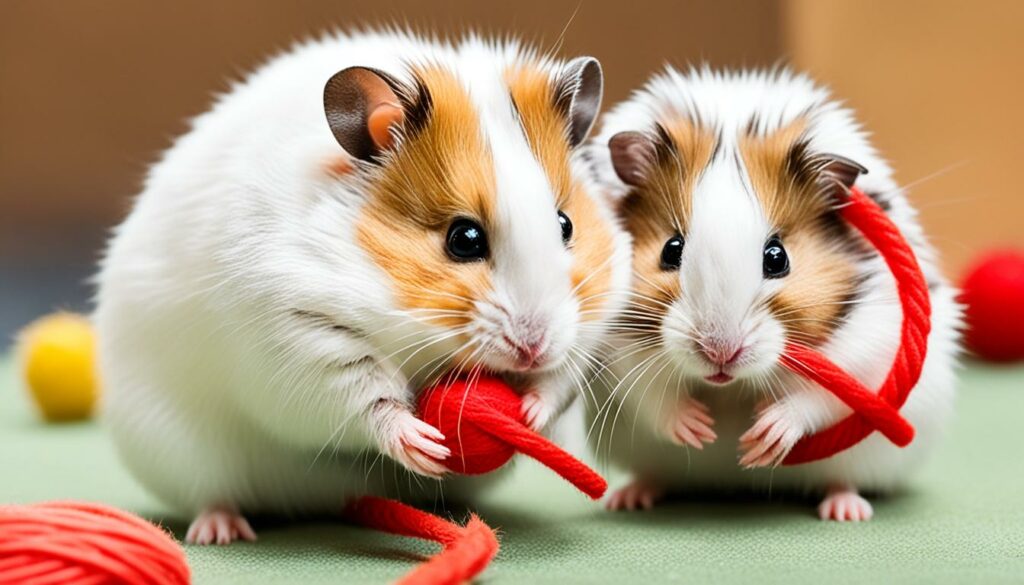
Regular Health Check-ups
Regular health check-ups are essential for the well-being of your hamster. During these check-ups, your veterinarian can examine their overall health and identify any potential issues related to chewing or yarn ingestion. By addressing these concerns early on, you can prevent the harmful effects of yarn on hamsters and take proactive steps in preventing yarn ingestion.
Your veterinarian will conduct a thorough examination, paying special attention to your hamster’s teeth. Hamsters’ teeth grow continuously, and regular chewing helps wear them down. However, if your hamster has been chewing on yarn, it may lead to dental problems such as overgrown teeth or dental injuries. The veterinarian will assess the condition of your hamster’s teeth and provide appropriate dental care if needed.
These check-ups also provide an opportunity for you to discuss any concerns or questions you may have about your hamster’s chewing behavior. Your veterinarian can offer guidance on preventing yarn ingestion in hamsters and recommend safe alternatives to satisfy their natural chewing instincts. They may also suggest specific hamster-safe toys and enrichment items that will keep your pet engaged and mentally stimulated.
Maintaining a Healthy Diet
In addition to regular check-ups, it is important to ensure your hamster has a balanced and nutritious diet. Providing a high-quality hamster pellet as a staple food is essential. These pellets are specifically formulated to meet the nutritional needs of hamsters and help support their overall health.
Supplement the pellet diet with fresh fruits and vegetables, along with occasional treats, following your veterinarian’s recommendations. Maintaining a healthy diet is essential to support your hamster’s immune system and overall well-being, reducing the risk of health issues related to yarn ingestion or other chewing behaviors.
Remember, if you notice any changes in your hamster’s behavior, appetite, or overall well-being, don’t hesitate to consult your veterinarian. Regular health check-ups, combined with appropriate care and attention to their chewing habits, will help keep your hamster happy and healthy for years to come.
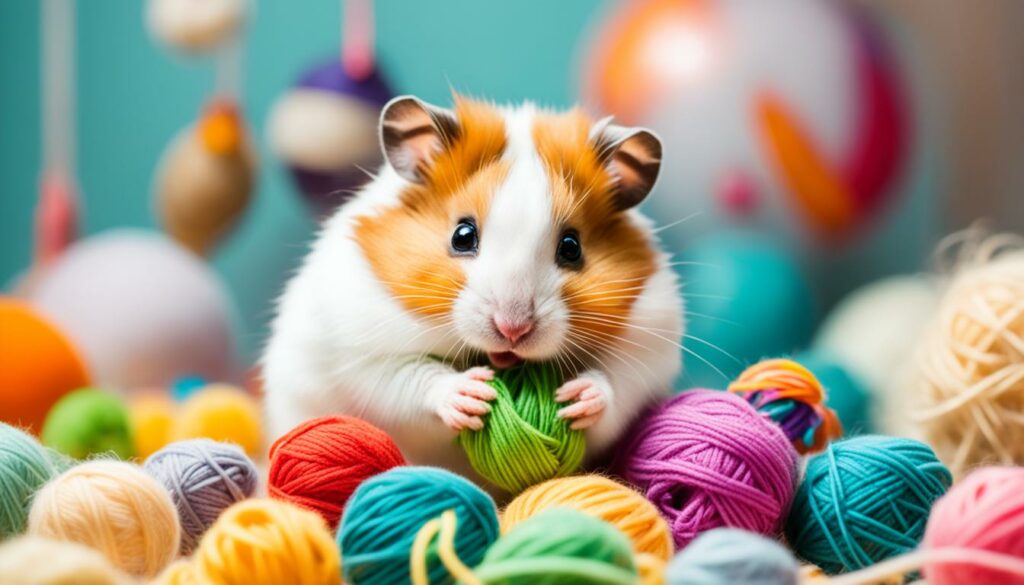
| Benefits of Regular Health Check-ups | Tips for Preventing Yarn Ingestion |
|---|---|
| – Early detection of dental issues | – Keep yarn and loose threads out of your hamster’s reach |
| – Timely intervention for potential health problems | – Provide safe alternatives to satisfy their chewing needs |
| – Expert guidance on hamster-safe toys and enrichment | – Create a hamster-safe environment in their cage |
| – Ensuring a balanced and nutritious diet | – Regularly inspect their habitat for potential hazards |
| – Peace of mind knowing you’re providing the best care | – Supervise your hamster during playtime outside the cage |
Conclusion
Understanding the potential risks associated with certain materials like yarn is crucial when it comes to the chewing behavior of hamsters. By prioritizing their well-being and safety, you can ensure a happy and healthy life for your furry friend.
Providing safe alternatives to yarn, such as natural chew toys made from pet-safe materials, is key in satisfying your hamster’s chewing instincts without putting them at risk. Additionally, creating a hamster-safe environment by removing any potential hazards, like loose threads or fibers, can help prevent accidents and yarn ingestion.
Being vigilant in monitoring your hamster’s chewing behavior is essential. Regularly check their habitat for any potential dangers and offer appropriate chew toys and enrichment to divert their attention away from harmful items. By doing so, you can ensure that your hamster remains happy and healthy, free from the potential harmful effects of yarn.

